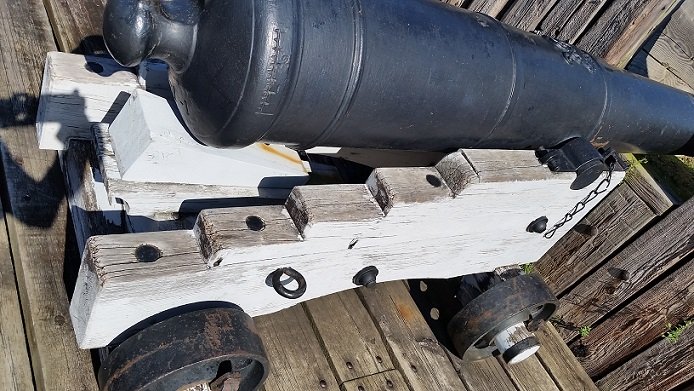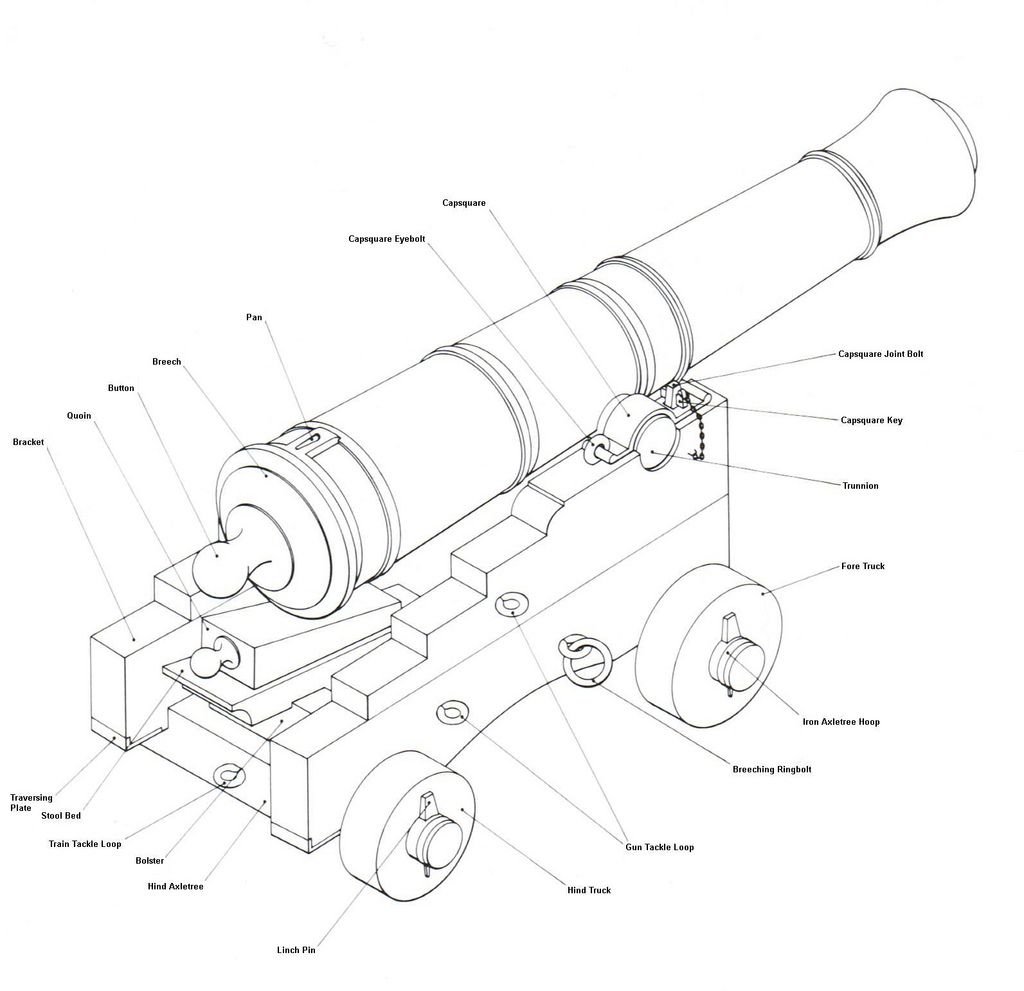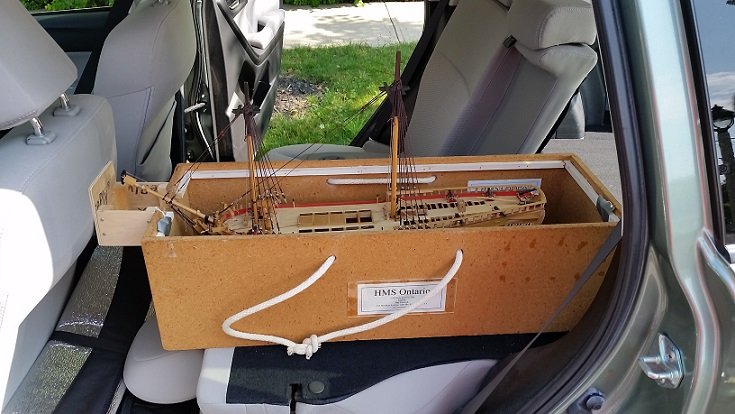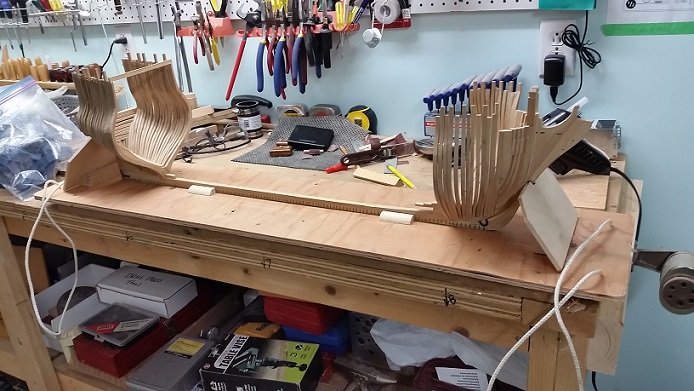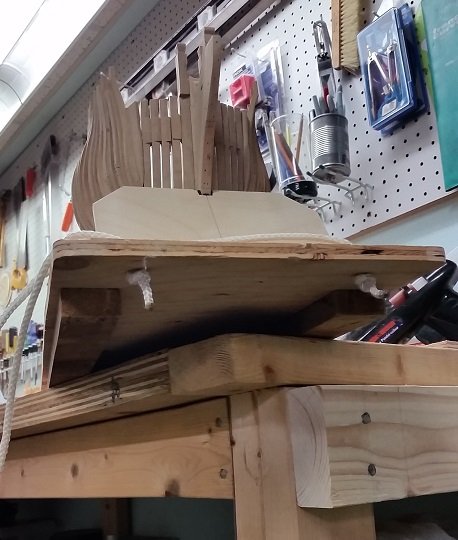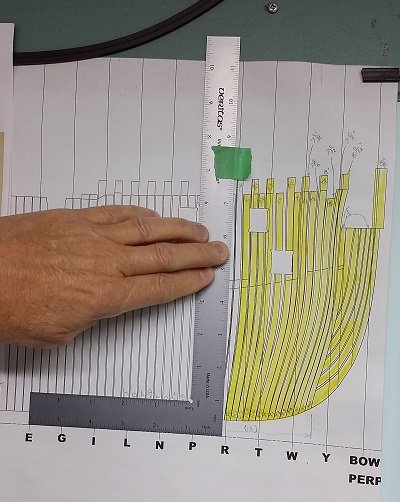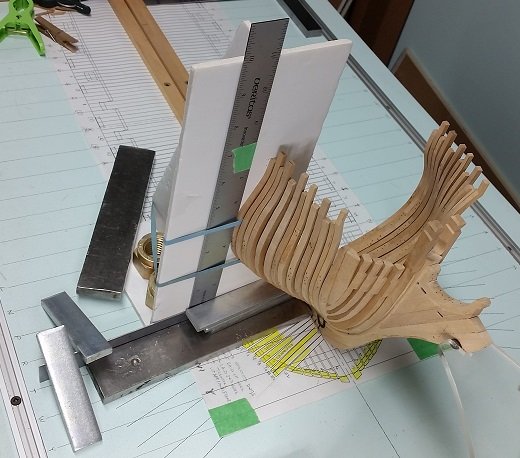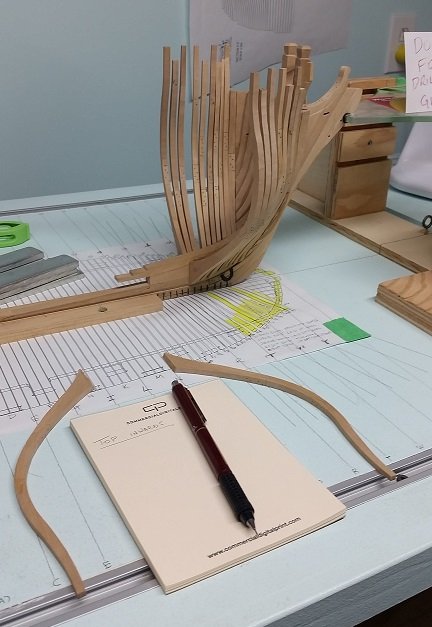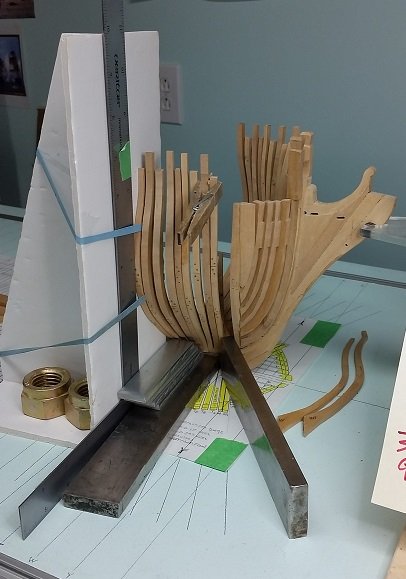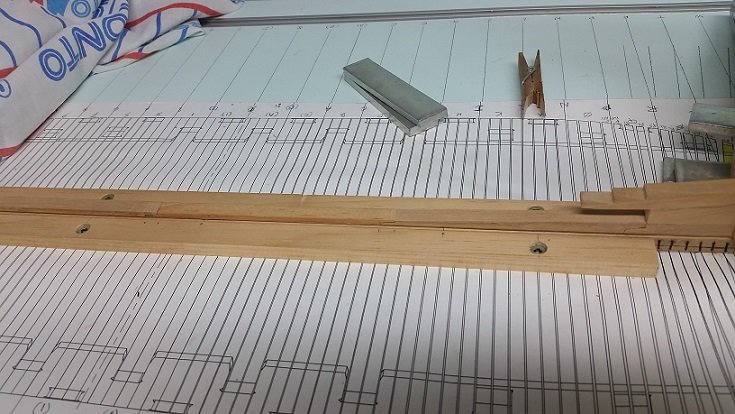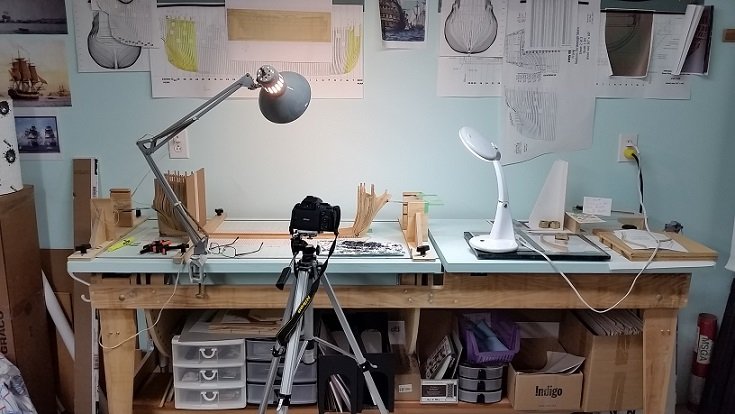-
Posts
2,861 -
Joined
-
Last visited
Content Type
Profiles
Forums
Gallery
Events
Everything posted by AON
-

Gun Spile
AON replied to Mark Allen's topic in Discussion for a Ship's Deck Furniture, Guns, boats and other Fittings
I would have said it was a naval carriage installed in a land base operated by the army so they put their barrel and metal wheels on it ... but what the heck do I know... then again the quoin is missing it's handle. I attributed this to Parks Canada. Possibly they Frankensteined the whole thing. Hmmmm???? -

Gun Spile
AON replied to Mark Allen's topic in Discussion for a Ship's Deck Furniture, Guns, boats and other Fittings
Here is a photo I took in October at Ft George in Niagara on the Lake. It does not have the metal on the lower corner of the cheek Possibly it is an era thing -

Gun Spile
AON replied to Mark Allen's topic in Discussion for a Ship's Deck Furniture, Guns, boats and other Fittings
I imagine it to be a protective wear plate on the bottom or lower rear corner of the cheek. I admit I did not notice these on the naval guns at Fort George in Niagara on the Lake here in Ontario, Canada. If I get my computer back this afternoon I will dig up the pictures I took this summer and have another look. -
Thanks for the reply re: treenail and plank sizing, Ben. I am trying to better appreciate why and when various size treenails are employed. Found a wooden ship building book dated 1919 with guidelines based on tonnage and joint location for treenails and bolts but not sure it hadn't changed from a century or two earlier.
- 889 replies
-
I think #18 is 0.018 diameter x 48 (at 1:48 SCALE) = about 7/8" diameter full size. May I ask: What thickness is the plank?
- 889 replies
-
Well the trip to the monthly club meeting, this time held at Lee Valley Tools in Niagara Falls, was a complete success. The ship made it there and back without any damage. She is back on the build table now. My presentation on DIGITALLY PHOTOGRAPHING SCALE MODELS was well received, or so I was told. If anyone is interested in downloading a PDF copy just visit our club website (Model Shipwrights of Niagara address below in my signature line) and go to our BLOG page. Scroll down a wee bit and it is there.
-

Gun Spile
AON replied to Mark Allen's topic in Discussion for a Ship's Deck Furniture, Guns, boats and other Fittings
-

Gun Spile
AON replied to Mark Allen's topic in Discussion for a Ship's Deck Furniture, Guns, boats and other Fittings
That wedge with the handle for adjusting the elevation of the canon is called the "quoin". A "spile is technically a cone with the pointed end cut off leaving a stubby plug. -

Need CAD type program
AON replied to Sambini's topic in CAD and 3D Modelling/Drafting Plans with Software
The free version of Draftsight will cease to run after 31 December 2019... they have decided to charge an annual fee. The hobby version will be $99 and does not do 3D. It is strictly 2D If you are able to spend more money there is a version that will do 3D. -
welcome aboard fitz301
-
Thought about taking pictures (yet again) but people don't come to the meetings to look at pictures. So today I made a carrying board which goes inside a cardboard box. As time goes on and things get taller I'll make a plywood box. I screwed two runners along the length on the underside for stiffness and added to pull ropes passing through holes in the plywood base with stopper knots (figure eight knot) so I can lift it out of the cardboard box. I did not invent this. One of the more skilled members of our local club made himself one... so I copied him.
-
Yes Druxey, you told me this last year for the aft cant frames and I did not forget. I am reluctant to do this until I have them all done and I am reasonably happy with the locations... as I might need to remove some to adjust before sanding (fairing). As you described, I find the aft frames are quite stiff now.
-

Gun Spile
AON replied to Mark Allen's topic in Discussion for a Ship's Deck Furniture, Guns, boats and other Fittings
-

Gun Spile
AON replied to Mark Allen's topic in Discussion for a Ship's Deck Furniture, Guns, boats and other Fittings
There is nothing mentioned in the Manual of Instruction for 18th century Artillery (including naval pieces). -

Gun Spile
AON replied to Mark Allen's topic in Discussion for a Ship's Deck Furniture, Guns, boats and other Fittings
From the Sailor's Word Book.... a tapered plug like thing. Would this be a plug in the muzzle or vent hole to keep the water out? -
I use a square to set the outside edge of my frame to the layout on the table top and also I mark the height on the frame onto the square with a piece of painters tape. Can't forget to check that the top or head of the frame aligns with the layout. All the R, T and W frames needed the heels sanded to match the inboard to outboard varying thickness change in the stem keel/apron/deadwood assembly as it is thicker inboard (top) than outboard (bottom). Now at stations P everything is practically flat which is making it a bit easier. I installed the last R frame to the starboard side late yesterday, and worked on frames P4, P3 and P2 yesterday and today. Frames P4 and P3 will be ready to install tomorrow but I will actually only get the two halves of P4 installed tomorrow. P2 will be ready Monday. We have our local club meeting Sunday so the ship won't get anything done on it that day. I am debating if I should take a chance and bring it to the meeting or not. Last time I did some of the frames were knocked off. Hmmmm... what to do?
-
I am transcribing some old newspaper postings and stumbled on the building of two different ships in the same yard for the British Royal Navy in 1785 that were assigned the same name. SQUIRREL - see below. Did this really happen?
-
It is annoying how we learn to look at things more critically as we get comfortable.... I mean experienced. Yesterday I popped off one set of forward cant frames to tilt the tops inboard a tiny smidgen (that is a technical term). These are back on today. Today I popped off three of the most forward cant frames on the starboard size to do the same. Tomorrow I will get the mates on the port side off. It is looking so much better with these minor adjustments. I have 2-1/2 sets are R frames to go before I start the installation of the P station cant frames. These have very small angles to them but I find the shaping of the timbers to take the chocks does not get easier. For a moment I was going to forego the bevel on these in the R and P station frames because the angle didn't seem like much, but I find it does still make a difference... so we carry on. Hope to be finished the cant frames next week as I can only manage to install one set a day and can make three sets ahead with the table space available as I prefer not to stack them. It's an CDO (or OCD) thing. Now I've just realized I have a problem with the method of clamping my keel to the work table Once I get all my square frames installed I won't have access to the screw heads to lift the model out. I need to loosen the screws to remove one side somehow. It was suggested I replace the screws with dowel pins so I can pry it up to remove it. I thought I might just replace the screws with bolts through from below and nuts on top. Seems simpler. Anyone have a better suggestion? And I need to make final adjustments to my presentation for this Sunday afternoon at the local club meeting (Model Shipwrights of Niagara) on Digitally Photographing Scale Models If interested, you will be able to download a PDF of the presentation from our website later next week. You can find a link to the website in the signature line below... go to the Blog page. And finally... yes, my derriere is all better now. There was some wicked deep bruising. They should invent a softer concrete for workshop flooring.
-
While transcribing posts from old newspaper articles regarding HMS Bellerophon, I came across the following today... Belfast Commercial Chronicle - Monday 6 January 1806 AUTHENTIC ACCOUNT OF THE DEATH OF LORD NELSON. About the middle of the action with the Combined fleets, on the 21st of October, Lord Nelson was upon the quarter deck, where he had resolved to take his station during the whole of the battle. A few minutes before he was wounded, Mr. Bourke was near him; he looked steadfastly at him, and said, "Bourke, I expect every man to be upon his station." Mr. Bourke took the hint, and went to his proper station in the cockpit. At this time his Lordship's Secretary, Mr. Scott, who was not, as has been represented, either receiving directions from him, or standing by him, but was communicating some orders to an officer at a distant part of the quarter-deck, was cut almost in two by a cannon shot. He was expired on the instant, and was thrown overboard. Lord Nelson observed the act of throwing his Secretary overboard, and said, as if doubtful, to a Midshipman who was near him, "was that Scott?" The Midshipman replied, he believed it was.. He exclaimed, "Poor fellow!" He was now walking the quarter-deck, and about three yards from the stern, the space he generally walked before he turned back. His Lordship was in the act of turning on the quarter-deck, with his face towards the enemy, when he was mortally wounded in the left breast by a musket-ball, supposed to have been fired from the mizen-top [sic] of the Redoubtable French ship of the line, which the Victory had attacked early in the battle. He instantly fell. He was not, as has been related, picked up by Captain Hardy. In the hurry of the battle, which was then raging in the greatest violence, even the fall of their beloved Commander did not interrupt the business of the quarter-deck. Two sailors, however, who were near his Lordship, raised him in their arms, and carried him to the cockpit, He was immediately laid upon a bed, and the following is the substance of the conversation which really took place in the cockpit, between his Lordship, Capt. Hardy, Mr. Bourke, and Beatty: Upon seeing him brought down, Mr. Bourke immediately ran to him. "I fear," he said, " your Lordship is wounded."---"Mortally, mortally."---"I hope not, my dear Lord; let Mr. Beatty examine your wounds."---"It is of no use," exclaimed the dying Nelson, "he had better attend to others." Mr. Beatty now approached to examine the wound---his Lordship was raised up; and Beatty, whose attention was anxiously fixed upon the eyes of his patient, as an indication the most certain when the wound is mortal, after a few moments glanced his eye on Bourke, and expressed his opinion in his countenance. Lord Nelson now turned to Bourke, and said, "Tell Hardy to come to me." Bourke left the cockpit. Beatty now said, "suffer me, my Lord, to probe the wound with my finger; I will give you no pain." Lord Nelson permitted him, and, passing his left hand around his waist, he probed it with the fore-finger of his right. The description of the surgeon, however, is so accurate and scientific, that, by his permission, we thankfully give it: "On his Lordship's being brought below, he complained of acute pain in about the sixth or seventh dorsal veterbra [sic], of privation of sense, and motion of the body and inferior extremities; his respiration was short and difficult; his pulse weak, small, and irregular; he frequently declared his back was shot through---that he felt every instant a gush of blood within his breast; and that he had sensations which indicated to him the approach of death. In the course of an hour his pulse became indistinct, and was gradually lost in the arm; his extremities and forehead became some afterwarde [sic] cold: he retained his wonted energy of mind and exercise if his faculties; until the latest mement [sic] of his existence; and when Victory, as signal as decisive, was announced to him, he expressed his pious acknowledgements thereof, and heart-felt satisfaction at the glorious event, in the most emphatic language. He then delivered his last orders with his usual precision, and, in a few minutes after expired without a struggle" COURSE AND SITE OF THE BALL ASCERTAINED SINCE DEATH. "The ball stuck the fore-part of his Lordship's epaulette, and entered the left shoulder immediately before the prosessus acromion scapulae, which it slightly fractured: it then descended obliquely into the thorax, fracturing the second and third ribs; and, after penetrating the left lobe of the lungs, and dividing in its passage a large branch of the pulmonary artery, it entered the left side of the spine, between the sixth and seventh dorsal vertebrae, wounded the medulla spinalis, and, fracturing the right transverse process of the seventh vertebrae, it made its way from the right side of the spine, directing its course through the muscles of the back, and lodged therein, about two inches below the inferior angle of the right scapula.---On removing the ball, a portion of the gold lace and pad of the epaulette, together with a small piece of his Lordship's coat, were found firmly attached to it. "W. BEATTY, SURGEON." When Bourke returned into the cockpit with Captain Hardy, Lord Nelson told the latter to come near him.---"Kiss me, Hardy," he exclaimed.---Captain Hardy kissed his cheek,---"I hope your Lordship," he said, "will still live to enjoy your triumph."---"Never Hardy!" he exclaimed, "I am dying---I am a dead man all over---Beatty will tell you so---bring the fleet to an anchor---you have all done your duty---God bless you."---Captain Hardy now said, "I suppose Collingwood, my dear Lord, is to command the fleet."---"Never," he exclaimed, "whist I live," ---meaning, doubtless, that, so long as his gallant spirit survived, he would never desert his duty. What passed after that was merely casual: his Lordship's last words were to Mr. Beatty, whilst he was expiring in his arms, "I could have wished to have lived to enjoy this; but God's will be done."---"My Lord." exclaimed Hardy, "you die in the midst of triumph"---"Do I, Hardy I" [?" - sic] ---He smiled faintly---"God be praised!" These were his last words before he expired. At the funeral of Lord Nelson of the 9th, the whole of the Morning Service will take place prior to the burial Service. The cable that now extends from the top of the dome, in ST.PAUL'S, is intended to hang all the colours of the different powers, taken by the gallant Lord. At the top will be displayed the English flag of the Victory, which , on a signal being given, will be lowered into the grave, with the remains of the ever to be lamented Noble Tar. The Plate upon Lord NELSON'S coffin is gold.---The dimensions are to be thirteen inches by nine. It is to be the same size as the Duke of GLOUSHESTER'S. His MAJESTY'S goldsmith is preparing it. The following inscription is to be upon it:--- DEPOSITUM. The Most Nobel Lord HORATIO NELSON, Viscount and Baron NELSON of the Nile, and of Burnham Thorpe, in the County of Norfolk. Baron NELSON of the Nile, and of Hillborough, in the said Country. Knight of the Most Honourable Order of the Bath; Vice-Admiral of the White Squadron of the Fleet; and, Commander-in-Chief of his Majesty's Ships and Vessels in the Mediterranean. Also, Duke of BRONTE, in Sicily; Knight Grand Cross of the Sicilian Order of St. Ferdinand, and of Merit. Member of the Ottoman Order of St. Joachim. Born September 29, 1758. After a series of transcendent and heroic Services, this Gallant Admiral fell gloriously, in the moment of a brilliant and de- cisive Victory over the Combined Fleets of France and Spain, off Cape Trafalgar, on the 21st of October 1805.
-
Canute I am glad you appreciate the old reports. They are definitely written on behalf of the victors. My favourite newspaper post to date is the announcement of the auction of the prize of a ship and the goods on board. It reminds me of the prize my grandfather lost out on in WWI. We had found a record of it. I was surprised they were still doing that then... at such a late date. I believe the practice of selling prizes and distributing the money is not done any more. As a kid I thought this was only done by pirates. I never found history as exciting in school. I suppose it is like a fine wine... gets better with ageing. It is likely why the younger generation repeat the mistakes of the past... they are not old enough to appreciate the lessons offered with the temperment if time. Am I old?
-
It has been over 24 hours and my wrist and hand are much better but not 100% as yet, possibly one more days rest is called for. However my butt reminds me of the fall every time I take a seat. Thank you Mark and all others for thinking so much of my favourite ship to have downloaded and reviewed my Part 1. The attached PDF is a preview of Part 2. It has a lot more to go so don't expect to see the finished product any time soon. Take care. Alan HMS Bellerophon - Part 2 - Newspaper Articles and Letters - 24 Oct 2019.pdf
About us
Modelshipworld - Advancing Ship Modeling through Research
SSL Secured
Your security is important for us so this Website is SSL-Secured
NRG Mailing Address
Nautical Research Guild
237 South Lincoln Street
Westmont IL, 60559-1917
Model Ship World ® and the MSW logo are Registered Trademarks, and belong to the Nautical Research Guild (United States Patent and Trademark Office: No. 6,929,264 & No. 6,929,274, registered Dec. 20, 2022)
Helpful Links
About the NRG
If you enjoy building ship models that are historically accurate as well as beautiful, then The Nautical Research Guild (NRG) is just right for you.
The Guild is a non-profit educational organization whose mission is to “Advance Ship Modeling Through Research”. We provide support to our members in their efforts to raise the quality of their model ships.
The Nautical Research Guild has published our world-renowned quarterly magazine, The Nautical Research Journal, since 1955. The pages of the Journal are full of articles by accomplished ship modelers who show you how they create those exquisite details on their models, and by maritime historians who show you the correct details to build. The Journal is available in both print and digital editions. Go to the NRG web site (www.thenrg.org) to download a complimentary digital copy of the Journal. The NRG also publishes plan sets, books and compilations of back issues of the Journal and the former Ships in Scale and Model Ship Builder magazines.



